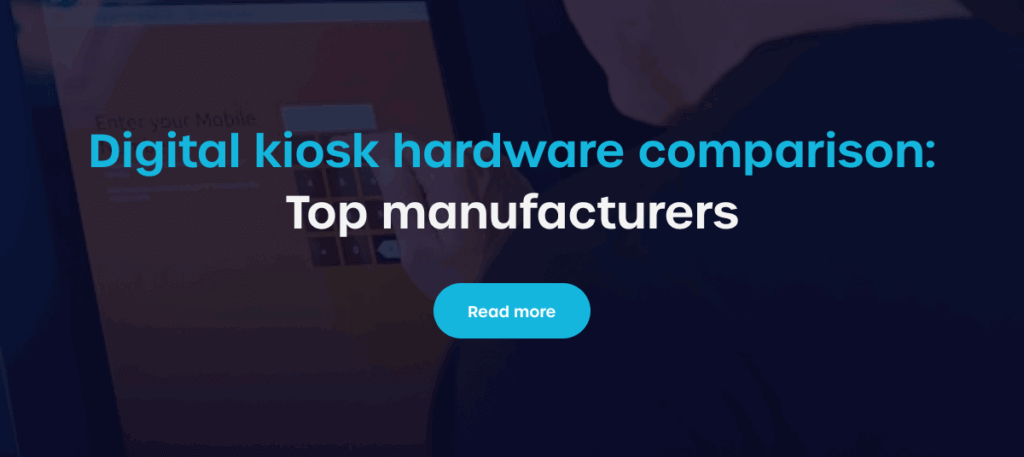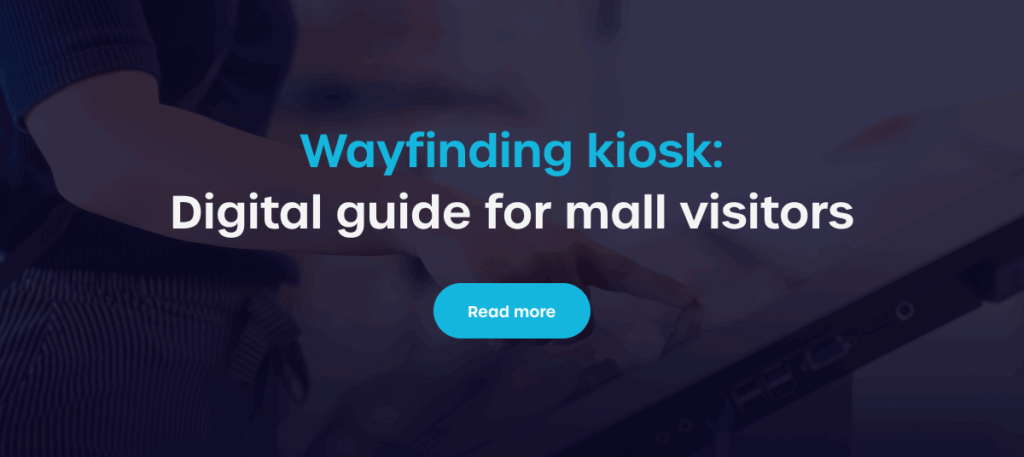Implementing an effective shopping center wayfinding system in a shopping center combines strategy, UX, and technology. Studies show that implementing wayfinding solutions in retail environments can reduce customer stress levels and increase satisfaction scores. This step-by-step guide takes you through the crucial stages: analyzing business needs and goals, mapping spaces and points of interest, selecting digital maps and intuitive mall information kiosks, designing content and user interface, and integrating tenant data. You’ll also learn how to plan a pilot rollout, conduct accessibility tests (WCAG compliant), launch the system, and monitor key performance indicators – ensuring visitors easily find shops and services while the center achieves measurable results.
Step 1 – Identify wayfinding goals for your shopping center
To effectively enhance the visitor experience at your shopping center, it’s essential to clearly define your wayfinding goals. Understanding what prompts visitor struggles during navigation will help you create a shopping center wayfinding system that meets their needs.
Define what visitors struggle to find
To build an effective shopping center wayfinding strategy, start by identifying what visitors find most difficult to locate. Gather feedback and insights to understand their real challenges, such as:
- Essential amenities – restrooms, baby changing areas, or ATMs.
- Vertical connections – escalators, elevators, or stairways.
- Specific destinations – individual stores, food courts, or customer service desks.
You can collect this information through:
- Surveys and feedback forms to hear directly from visitors.
- On-site observation to see how people move and where they hesitate.
This foundation will help you design a wayfinding system that reduces confusion and creates a smoother shopping experience.
Set clear objectives
Once visitor pain points are identified, the next step in improving shopping center navigation is to set clear and measurable objectives. These objectives should directly address navigation challenges, such as reducing the time visitors spend searching for specific stores or improving satisfaction scores related to wayfinding.
By defining precise targets, you create a roadmap for both implementing and evaluating the effectiveness of your wayfinder kiosk system. Clear goals also provide benchmarks that help track progress and highlight areas for improvement. Most importantly, they keep your team aligned and focused on delivering a seamless shopping experience that makes visitors feel confident and supported.
Step 2 – Select the wayfinding system type and hardware
Choosing the right system is crucial for effective navigation within your shopping center. Consider the attributes of different systems, like wayfinding kiosks, mobile apps, and interactive directories, to find the perfect fit for your environment.
Choose between digital kiosks, mobile apps, and interactive directories
When planning your shopping center wayfinding system, it’s essential to choose the right format for your visitors. Each option comes with its own strengths and limitations, so the decision should be based on both functionality and shopper preferences. By aligning the solution with your audience, you ensure a smoother navigation experience and greater visitor satisfaction.
- Digital kiosks – act as central navigation hubs, offering detailed maps, store searches, and quick access to amenities. They are highly visible and accessible to all visitors, making them a reliable choice for first-time shoppers.
- Mobile apps – deliver a personalized experience with real-time updates but require visitors to download and use their own devices. They work best for frequent shoppers who value convenience and tailored recommendations.
- Interactive directories – combine navigation with promotional opportunities, making them ideal for showcasing offers while guiding shoppers. They also allow for flexible updates, ensuring information about stores and deals stays current.
Choosing the right mix of these solutions will maximize accessibility and ensure your wayfinding strategy meets the needs of every type of visitor.
Pick hardware that fits your mall’s layout and environment
Selecting the right hardware is a critical step in building an effective shopping center wayfinding system, as it must align with both the mall’s layout and its environmental conditions. Hardware placement should take into account natural visitor flow, ensuring kiosks are positioned where they are most visible and accessible, such as near entrances, escalators, or busy intersections. Lighting also plays an important role - poorly lit areas can make kiosks harder to notice, while glare from strong lighting may reduce screen readability.
In addition, malls with outdoor areas face unique challenges, requiring durable systems that can withstand changing weather conditions, from temperature fluctuations to moisture and direct sunlight. By thoroughly assessing these factors, you can ensure your wayfinding hardware is not only reliable but also enhances the visitor experience. To make the selection process easier, we have prepared a detailed article about digital kiosk hardware comparing available options. This guide can help you choose hardware that best matches the specific needs of your shopping center.

Step 3 – Design the wayfinding interface and map
The design of your wayfinding interface and map shapes how shoppers interact with it. A user-friendly and visually appealing layout makes your shopping center wayfinding systems more engaging.
Create an intuitive interactive map with clear routing
An effective interactive map is the centerpiece of any shopping center wayfinding system, guiding visitors smoothly from their current location to their chosen destination. The map should allow users to quickly search for or select their destination, then provide clear, step-by-step navigation with minimal effort. Pathways need to be displayed logically, with routes optimized for both speed and accessibility, ensuring visitors can move easily whether they are on foot, with strollers, or using mobility aids. Key locations such as restrooms, escalators, elevators, parking areas, and customer service desks should be highlighted so they are instantly recognizable.
To reduce confusion, use consistent visual language – symbols, icons, and color coding that are universally understandable and friendly to all age groups. Incorporating features like “You are here” indicators and dynamic zooming further enhances usability, while maintaining a clean and uncluttered layout prevents information overload. By combining clarity, accessibility, and intuitive design, your interactive map will streamline navigation and significantly improve the shopping experience for every visitor.

Align the visual design with your shopping center’s branding
Your shopping center wayfinding system should not only guide visitors but also reinforce the identity of your center. By aligning the visual design with your branding, you create a seamless and memorable experience that feels consistent from the first impression to the last interaction. The use of cohesive design elements builds trust, enhances recognition, and strengthens the overall perception of your shopping center.
Key elements to consider include:
- Colors – Apply your brand’s color palette to ensure the system feels like an extension of your center’s identity.
- Fonts and typography – Use the same or complementary fonts featured in your marketing materials to maintain consistency.
- Graphics and icons – Incorporate visual elements that reflect your brand style, making the interface intuitive and recognizable.
- Tone and style – Ensure the look and feel of the design align with the emotions you want your brand to evoke, whether that’s luxury, family-friendly, or modern.
An appealing and cohesive design not only makes navigation easier but also encourages visitors to interact more deeply with your wayfinding solutions, ultimately enhancing their overall shopping experience.


Step 4 – Deploy, test, and maintain the wayfinding system
Deploying your shopping center wayfinding system is just the beginning; ongoing testing and maintenance are essential to keeping it effective. Scheduling regular reviews and updates will help identify issues such as outdated store information, technical malfunctions, or usability challenges before they negatively affect visitors. Consistent monitoring also ensures that maps remain accurate as store layouts change, promotions are updated, or new amenities are introduced
Install devices, test navigation, and fix errors
Once your hardware and software are installed, the next step in building a reliable shopping center wayfinding system is comprehensive testing. Every navigation path should be verified to ensure visitors can move from their current location to any store, amenity, or service point without confusion or dead ends. It is equally important to check the responsiveness and clarity of the touchscreen interface, ensuring that users of all ages can interact with the kiosks easily and intuitively. Staff should also be trained to understand the system’s functions and basic troubleshooting so they can quickly assist visitors when needed. By combining technical validation, user testing, and staff preparedness, you can deliver a smooth, frustration-free navigation experience.
Crucial steps include:
- Test navigation paths thoroughly – verify routes between all stores, amenities, and multi-floor connections.
- Check accessibility features – ensure smooth navigation for visitors with strollers, wheelchairs, or mobility aids.
- Validate kiosk usability – confirm that touchscreens are responsive, menus are intuitive, and maps are easy to read.
- Run real-user trials – gather feedback from shoppers to identify overlooked issues or confusing elements.
- Train staff for support – equip employees with knowledge of the system to troubleshoot problems and assist visitors.
- Fix errors promptly – resolve any technical or design flaws before the system goes fully live.

Set up regular updates, support, and data monitoring
A shopping center wayfinding system is not a one-time installation – it requires consistent updates and monitoring to remain effective and relevant. By establishing a structured maintenance schedule, you can ensure that both the software and hardware continue to meet visitor needs while adapting to changes in your shopping center. Ongoing updates, active support, and data-driven improvements not only keep the system functional but also enhance the overall shopping experience.
Practices to include:
- Regular software updates – introduce new features, fix bugs, and improve performance to ensure smooth operation across all devices.
- Content refreshes – keep store directories, promotions, and amenity information up to date so visitors always access accurate details.
- Data monitoring and analytics – track usage patterns, popular searches, and navigation bottlenecks to gain insights into visitor behavior.
- Proactive hardware checks – inspect kiosks, screens, and interactive directories to prevent failures before they disrupt navigation.
- Visitor support system – provide help options on kiosks or train staff to assist shoppers who encounter difficulties.
- Feedback collection – encourage visitors to share their experiences, making it easier to identify areas for improvement.
Consistent upkeep not only ensures the reliability of your system but also builds trust with shoppers, encouraging repeat visits and long-term loyalty.

FAQ - Shopping center wayfinding system
What is a shopping center wayfinding system and how does it work?
A shopping center wayfinding system is a navigational tool designed to assist visitors in finding their way around the complex. It typically includes interactive kiosks, mobile apps, or digital displays that provide maps and store information. These systems analyze visitor interactions to continuously improve the navigation experience and help shoppers locate retailers, dining options, and amenities quickly. Ultimately, they enhance overall shopping center wayfinding and visitor satisfaction.
How much does it cost to implement a shopping center wayfinding system?
The cost depends on the technology, scale, and level of customization.
- Initial setup – costs can range from a few thousand to several hundred thousand dollars depending on kiosks, mobile apps, and integration.
- Additional expenses – include installation, staff training, and system customization.
- Ongoing maintenance – covers software updates, hardware checks, and content management.
A well-planned investment ensures long-term visitor satisfaction and increased foot traffic.
Can I integrate the shopping center wayfinding system with mobile app?
Yes, integrating your wayfinding system with a mobile app is a highly effective strategy for providing a seamless experience to shoppers. This integration allows visitors to access maps and directions directly from their smartphones, enhancing convenience and engagement. Investing in this technology provides a competitive advantage and caters to the growing trend of mobile-first solutions in shopping environments. Collaboration with app developers can help streamline this process and ensure optimal user experience.
How long does it take to install a shopping centre wayfinding solution?
The installation timeline varies based on the size of the centre and the complexity of the system.
- Overall duration – typically ranges from several weeks to a few months.
- Process stages – include planning, installation, testing, and staff training.
- Efficiency factors – strong project management and vendor coordination can speed up the launch.
With proper organization, the system can be deployed smoothly and on schedule to meet visitor needs.







